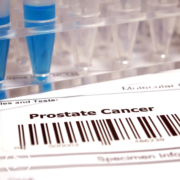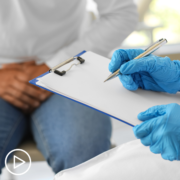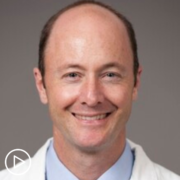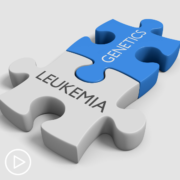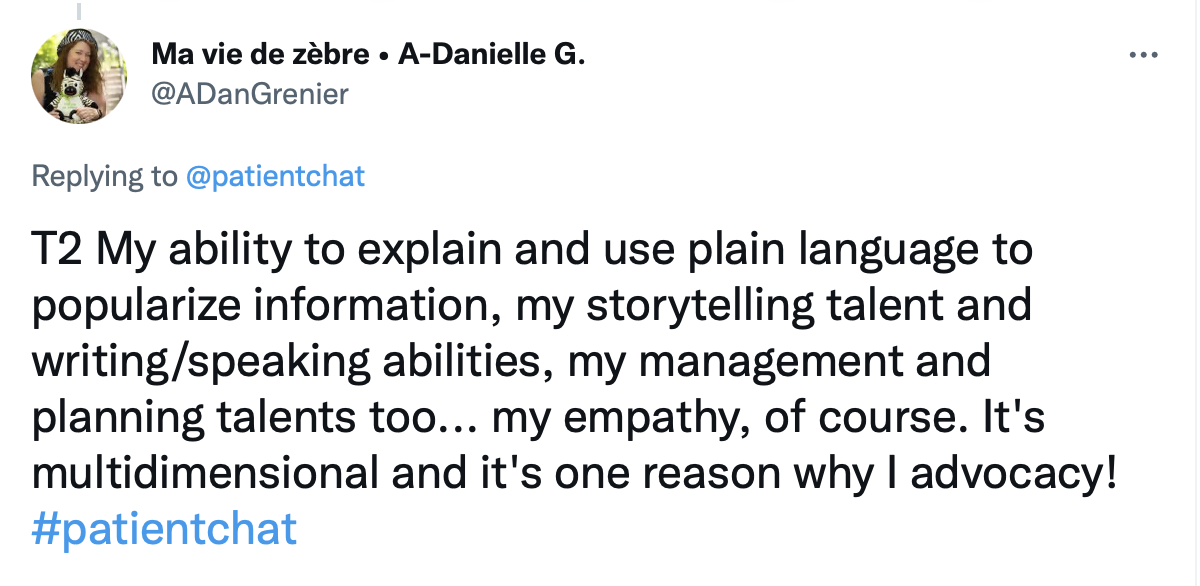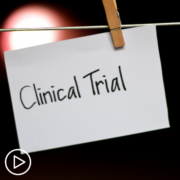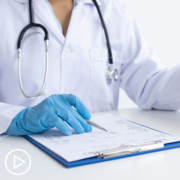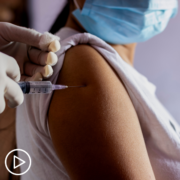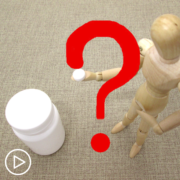How Clinical Trials Advance MPN Treatment and Research from Patient Empowerment Network on Vimeo.
MPN expert Dr. Angela Fleischman provides a deeper understanding of how clinical trials advance myeloproliferative neoplasm (MPN) research and treatment, explains safety protocols in place for trials, and addresses common misconceptions associated with clinical trial participation. Dr. Fleischman also shares an update on emerging MPN research.
Dr. Angela Fleischman is a physician scientist and assistant professor in the Department of Medicine at the University of California, Irvine. Learn more about Dr. Fleischman.
See More From MPN Clinical Trials 201
Related Programs:
Transcript:
Katherine:
Hello, and welcome. I’m Katherine Banwell, your host for today’s program. Today, we’re going to discuss how clinical trials advance research for myeloproliferative neoplasms, or MPNs, and we’ll talk about what MPN patients should know about participation.
Before we get into the discussion, please remember that this program is not a substitute for seeking medical advice. Please refer to your healthcare team about what might be best for you.
Well, let’s meet our guest today. Joining me is Dr. Angela Fleischman. Dr. Fleischman, welcome. Would you please introduce yourself?
Dr. Fleischman:
Thank you very much for the invitation. Hi, everyone. My name is Angela Fleischman. I’m what’s called a physician scientist, meaning, I do research as well as see patients, and my focus for my entire career thus far has been on myeloproliferative neoplasms, specifically their role of inflammation in MPN. And I am at the University of California, Irvine in Southern California. So, nice to be here today.
Katherine:
Well, thank you so much for joining us and taking the time. Before we get into the discussion about clinical trials, because you’re so heavily involved in research, let’s talk about the latest developments in the field. What MPN clinical trials are you excited about right now?
Dr. Fleischman:
So, I would say, there’s a lot of new clinical trials in the field for myelofibrosis, which is the most severe form of myeloproliferative neoplasm.
There tend to be more clinical trials because that’s a patient population in – I don’t want to say in more need, but they do have more need in terms of necessitating better treatments.
Drugs that are quite far along in clinical trials – and in order for a drug to make it to market, one needs to go through multiple clinical trials to demonstrate the safety, as well as efficacy. Things like a BET inhibitor are very, very promising in moving forward in clinical trials. Other medications for other diseases, such as polycythemia vera, not anymore in clinical trials, but excitingly, newly FDA-approved, was ropeginterferon for polycythemia vera.
So, that’s a real exciting development for Polycythemia Vera patients.
And now, we have – outside of the context of clinical trials, because I want to talk about what’s actually available to patients now, we now have three JAK inhibitors available for myelofibrosis patients. And really, since 2011, we had only had one, and then, more recently, a second JAK inhibitor, but now, we have three. So, now we’re moving into an era where we can tailor a specific JAK inhibitor for a specific myelofibrosis patient, depending on what their particular needs are. So, I think that that’s very promising. And then, there are lots of clinical trials combining JAK inhibitors with new drugs.
Katherine:
So, how does it work? How do clinical trials advance MPN research and treatment?
Dr. Fleischman:
Well, there are multiple stages of clinical trials. One needs to have some rationale for testing a specific drug in patients. You just can’t say, I just want to take something off the shelf and see if it works for myeloproliferative neoplasms.
There could be different ways that things sort of enter into clinical trials, either preclinical data from in vitro, meaning, in the lab, in the liquid media, with cells, that makes somebody think that it might work in humans, or that it works in a similar disease to myeloproliferative neoplasm. So, it’s a little bit of a stretch, but a very rational stretch, to then test it in a new population.
First and foremost, safety needs to be evaluated, because as physicians, one of our primary objectives is to do no harm to patients. So, at very early stages of clinical trials, the primary objective is to see what the appropriate doses, what’s tolerated, what the side effect profile is.
And then, moving on to efficacy. So, maybe it’s tolerated, but does it actually work at the next stage of clinical trials. Then, a much larger clinical trial would be to do a head-to-head comparison between, in most cases, standard of care versus drug X.
And I think, for clinical trials, in particular, for myeloproliferative neoplasm, it’s very important to understand what the stated, primary end point is, in particular, for myelofibrosis patients, that myelofibrosis patients may have different problems. Some myelofibrosis patients, their primary issue may be anemia. And so, if they’re looking for a clinical trial to address their anemia, they would probably want to be looking for one whose primary end point is transfusion, freedom from transfusions, or improving the anemia, not necessarily – there was another trial that’s primarily looked at spleen reduction, but they didn’t have an enlarged spleen, that, necessarily, wouldn’t be appropriate for the patient.
So, I think it is particularly important in myeloproliferative neoplasm to identify what the primary end point is, and whether what you’re going for is that primary end point.
Katherine:
Mm-hmm. Any advances that are being done in MPN research require MPN patients to participate in clinical trials, right?
Dr. Fleischman:
Of course.
Katherine:
So, to start, let’s talk about where clinical trials fit into the treatment plan for ET, PV, and MF patients. When should a patient consider participating in a clinical trial?
Dr. Fleischman:
Okay, well, I guess a patient could really consider participating in a clinical trial at any point if they had a very altruistic philosophy, that understanding that their participation may not necessarily help them at this moment in time, but may help others in the future, and we’ll gain knowledge about myeloproliferative neoplasms.
That’s one approach.
Another approach, which is probably a more usual approach, is when a patient has already tried standard therapies and they haven’t quite worked for them, or they’re in a class where, maybe, we don’t have really great standard therapies for somebody.
For example, a myelofibrosis who may not be doing too well and may not necessarily be a candidate for a transplant, I think that’s a very reasonable population to go out and seek clinical trials, because there’s really not necessarily a great standard of care treatments for that patient population, or ET or PV patients who have tried standard of care and, maybe, can’t tolerate standard medications, or they’re just not working for them.
But really, anytime somebody can do a clinical trial, if that’s what they feel is important to them.
Katherine:
What are the benefits and risks of a trial participation?
Dr. Fleischman:
So, the benefits are that you’re getting a drug that, potentially, is better than standard of care, that could be standard of care five to 10 years from now, but you’re getting it early.
As investigators, ethically, we can’t start a clinical trial if we believe that the drug that we’re testing might have negative side effects on the patient, or maybe worse than standard of care. I mean, ethically, that’s not appropriate. So, ethically, we believe that what we’re testing may be better than what we’re currently giving patients, but we don’t know that. So, that’s the purpose of a clinical trial.
So, a clinical trial, it’s a new drug. So, could have side effects that are on unanticipated, including death. I mean, that’s just the reality. That would be a very uncommon scenario, but it’s an unknown, so it’s an unknown.
Other things that I think are very important to discuss are the financial implications of a clinical trial. On the pros, one could be getting a free drug that is outside of standard of care, and many of the tests that are done for the purposes of the research are covered. However, drugs, say, if it’s a combination drug, standard of care plus a new drug, the standard of care drug is usually billed to insurance. And so, the patient would need to pay for that, or if there are studies that would be considered standard of care, the patient would need to cover them.
So, I think it, really, is important to discuss the financial implications. What money is it going to save you by participating, and may there be extra costs, or hidden costs, potentially, involved by participating?
Katherine:
Yeah. Let’s talk about safety in clinical trials. Would you review the safety protocols that are in place before a clinical trial even begins?
Dr. Fleischman:
So, before a clinical trial begins, there, usually, needs to be safety information in animals. Also, a lot of drugs have been tried in other diseases first. Either, they’re, have been studied in clinical trials and maybe not found to be very efficacious, but at least we have the value of the safety data in another population.
So, we’re entering, again, into clinical trials with the understanding that it would not be harmful to humans with the data that we have available in animals, or in liquid culture. But again, we just don’t know that. And then, also, for many clinical trials, starting off at lower doses, and then, increasing the dose slowly in different cohorts of patients, to see what’s the maximally tolerated dose.
As well as, when somebody is on a clinical trial, safety and side effects are very closely monitored, and even small side effects that likely have nothing to do with the drug, really do need to be investigated fully, just to make sure that they’re not related to the drug.
Katherine:
Yeah. How do you know if the medicine is safe prior to starting a human trial?
Dr. Fleischman:
That’s a great question.
Based on what the molecule looks like, as well as, many times, they’ve been tested in animals to see – for example, for myeloproliferative neoplasm, it would be important to know, does it change a healthy rat’s blood count? Does it harm their liver? Those sorts of things, and safety information is usually available for a new drug.
Katherine:
Are patients monitored more closely when they’re in a trial?
Dr. Fleischman:
Yes, definitely. And for the purposes, mainly, of paying very close attention to even small side effects that, if somebody was not watched closely, may be missed because they’re so subtle.
Katherine:
What if a patient decides to leave a trial? Does that negatively impact their care?
Dr. Fleischman:
No, and I think that’s a very important point, that, ethically, as investigators, we cannot – and we do need to make it a point to communicate this fully with the patient, that when we’re asking the patient, or informing them about a potential clinical trial, we need to inform them that whether or not they participate will have nothing to do with the way that we treat them. We will treat them equally, regardless of whether or not they participate, as well as, anytime during the clinical trial, a patient has the absolute right, for whatever reason, they can decide to leave the clinical trial. That’s the most – I don’t say that’s the law, but those are the rules of clinical trials, as well as, a patient cannot be treated differently if they decide to leave a clinical trial.
We have to be fair. I mean, this is – you have to be fair to all patients, and all patients deserve excellent treatment, regardless of whether they participate in the clinical trial.
Katherine:
Dr. Fleischman, we’ve been talking about what happens when people participate in trials. But what if they don’t? Why is it crucial that patients participate in trials?
Dr. Fleischman:
Because without participation in clinical trials, we are not going to further our understanding of myeloproliferative neoplasm. Many of the drugs that we use today in myeloproliferative neoplasms, as well as other diseases, the reason why we use them today is because people 10, 20 years ago participated in the clinical trial and demonstrated a benefit of these medications. So, people don’t participate, we’re not going to have new drugs for myeloproliferative neoplasms.
Katherine:
All right. We know that much of the reason that people don’t participate is because of various stigma associated with clinical trials, and I’d like to talk about that with you.
Let’s start with the word “experiment.” Why does this word not pertain to clinical trials?
Dr. Fleischman:
So, I think the word “experiment” may have a negative connotation, and making the patient think, maybe they’ll say, a guinea pig. The only way that we can identify whether a drug is going to be beneficial is to test it out in humans with a particular disease.
So, I mean, on one hand, it is an experiment, because we don’t know what’s going to happen, but we’re doing the experiment for the benefit of people who are suffering from the same disease.
Katherine:
Yeah. Yeah. That’s a good explanation. What would you tell patients who are worried that they will receive a placebo?
Dr. Fleischman:
So, that is part of a clinical trial, and it is also important to look how your clinical trial that you’re interested in is structured.
So, some clinical trials do receive, or split into placebo, or active drug, and double-blinded means that the patient doesn’t know, nor the physician knows. So, no one knows, and that’s important because we don’t want to sway any subconscious things that, if you know you’re getting the drugs, then you’re going to say your symptoms are getting better, things like that.
Again, ethically, in a clinical trial, we cannot not give somebody treatment that they – we can’t keep treatment from somebody. So, for example, if a person with polycythemia vera was a, per guidelines, should be on a cytoreductive agent, we cannot, ethically, treat them without a cytoreductive agent. So, it would be – they would have standard of care plus placebo, or drug X.
So, maybe I’m not explaining this correctly, but if a placebo study is done, the placebo can’t take the place of something that we know is good for the patient.
We can’t leave them hanging without any treatment, unless, for their specific situation, there’s not, necessarily, a known standard treatment, that it would be very reasonable to treat them with nothing.
Katherine:
Another myth we often hear is that trials should only be considered if you have no other options. Why is that false?
Dr. Fleischman:
I think there is a place for patients with no other options that – they may be more inclined to participate in, I want to say, higher risk studies, in which there’s less data to support a particular medication. But that’s why we look at these drugs in patients with no other options, because there’s no other reasonable thing to give them.
But the patients with no other options may not be an accurate representation of the patient population, as a whole. So, it is important for people who may have other options, but maybe they want to think about, well, I do have a standard option, but maybe there’s something better out there for me, to participate in clinical trials.
Katherine:
What if an MPN trial isn’t offered at the center where a patient receives care? What can they do?
Dr. Fleischman:
Many times, specific clinical trials are only open at specific universities. And so, it’s very likely that your university, or the place where you receive care, may have a few clinical trials, or maybe one, or maybe zero for MPNs, but may not necessarily fit your exact circumstances.
So, what I would recommend is, doing searching on your own, either through clinicaltrials.gov, or the MPN Research Foundation also has some nice resources, but doing some research on your own to identify some potential clinical trials that you’re interested in, and then go to your primary oncologist and say, “Hey, I printed these out. I think these might look really interesting to me.”
And usually, on clinicaltrials.gov, they would have where they are, and you can actually, also, search for your state. So, maybe bring some that are close to you, and discuss with your primary oncologist the pros and cons of them. And then, ask your primary oncologist to make a referral to the location where they offer that specific trial.
And a lot of times, you can – there’s a phone number you can call and be pre-screened. Say, “Hi, I’m a 55-year-old man with myelofibrosis,” and there are specific inclusion, exclusion, criteria that they can ask you. And if you don’t meet the inclusion criteria, then it’s not worth your time to go and have an actual visit, but if you do meet the inclusion criteria, then you could go and have an actual visit, and learn a little bit more.
Katherine:
Oh, that’s great information. Thank you. Here’s a question we received from an audience member, prior to the program. Susan wants to know, “How can I get my community oncologist on board with trial participation? I’m interested in participating in a clinical trial that’s based in Chicago, and I’ll need her help in coordinating care with the team from a distance. Any advice for how to talk to my local doctor about that?”
Dr. Fleischman:
So, that may be a tough one. So, many times, if somebody has to travel for a clinical trial, it does require some coordination. There are specific – and it’s clinical trial specific. There may be specific things that actually need to be done at the study site. For example, specific labs that would be drawn, and say, need to be frozen within two hours, or specific tests, for example, MRIs, if you need to look at the spleen size, you would need to do it on the same machine for everyone.
So, there are specific things that have to be done at the location, or if it’s written to the protocol, you have to come to the location for a physical exam on this day and this day, and if it’s not within a two-to-three-day window, then there’s a deviation, and the data is not valid.
So, what I would say is – sorry, this is a long answer here, but where certain things, if they’re written in the protocol that say a CBC could be drawn at any institution at week four, then that would be reasonable to have your primary oncologist do. But in the context of clinical trials, certain things are really set in stone as to the exact dates that needs to be done, and the exact location. And if they’re not done exactly, to a tee, then your data will not be – your data cannot be used for the analysis.
Katherine:
Mm-hmm. But then, there’s also the issue of patients being willing and able to travel a distance to a teaching university where a clinical trial might be happening.
Dr. Fleischman:
Correct, yes. And I think that, for some clinical trials, when the protocol is made, understanding that trying to minimize the trips to the actual site, and working the protocols, working some sort of wiggle room in the protocol, such that lots of stuff, or hopefully, lots of stuff, can be done remotely. But sometimes, it’s just not possible.
Katherine:
Yeah. I’d like to turn our conversation to health disparities, Dr. Fleischman. Based on American history, some people believe that they won’t receive equitable or safe care if they participate in a trial.
How can you reassure those people who are concerned they’ll be treated fairly?
Dr. Fleischman:
Now, I think that this is a very important point, and something that there’s been a lot of emphasis, to try to improve diversity in clinical trials, because our American population is quite diverse. However, the participants that, in general, participate in clinical trials are, unfortunately, still have not a very diverse population in our clinical trials.
I think what we need to first start doing is education, to reach out to underrepresented communities, to start to build the trust amongst these communities, to tell them about the value of clinical trials. And I think it’s going to take some time to build trust first, because it does take quite a bit of trust to participate in the clinical trial.
But I don’t have a great answer for that, other than, we need to work hard to, first, build trust, and then, I think the diversity will come.
Katherine:
Mm-hmm. How does holding on to some of these beliefs lead to limitations in care and create disparities?
Dr. Fleischman:
So, and rightfully so, if a patient is scared, or has some reservations of participating in a clinical trial, they may – that’s offered to them, that they provide them with, potentially, something better than standard of care. They may be missing out on a potential opportunity.
Also, potentially, if a patient, if they’re asked about a clinical trial and they have a negative connotation about them, they may lose trust with their physician, if they say, oh, my physician is asking me to participate in a clinical trial.
This means that they’re thinking of me as an experiment, and maybe they’re not really thinking of me as patient. And so, they may not have that trust with their physician, and so, may not be as open, in terms of communication, with their physician.
I think it all boils down to trust, and as physicians, we need to demonstrate that we are worthy of the patient’s trust, and we really are ingrained in us to treat every patient the same. I mean, that’s what our oath is. That’s what we’re supposed to do, and I think that the vast majority of patients, they have, ethically, are treating patients exactly the same, regardless of their circumstances.
Katherine:
Yeah. Health equity means that no matter what a patient’s circumstances, whether it be race, income issues, lack of education, that they should have access to the best care. What is being done by the medical community to address this issue?
Dr. Fleischman:
So, yes, this is a significant issue, and in particular, with myeloproliferative neoplasms, in whom there are lots of oral drugs – or with interferons, it’s injectable, but you get the prescription, and you give it to yourself – that there can be quite high copays, in some cases, exorbitant amounts, which, really, are not able to be paid for by the vast majority of people.
So, many companies do have copay assistance programs. Also, foundations have copay assistance programs. So, I think that is, at least, one step in trying to make things more equitable, to get people who need a drug, their drug, at a very reasonable cost. Again, it does take some time, some legwork on the part of the patient, to seek out these programs, or to find an advocate for themselves to seek out these programs for them.
Katherine:
Yeah. Would a healthcare team be part of that process, though? Would they be able to help the patient?
Dr. Fleischman:
They will be able to help the patient in terms of saying, “Hey, there’s this program for this drug. Why don’t we fill out the form together?” Or, “Why don’t you call this,” you know. Many times, the patient needs to initiate the process. So, I think the healthcare team can sort of guide the patient in saying, this is what’s available, we can help. We can fill out our portion of the form, you fill out your portion of the form. But no, it does need to be – the patient needs to be an active participant in seeking out the support.
Katherine:
Mm-hmm. Before we end the program, Dr. Fleischman, I’d like to close with some advice from you. What do you want to leave MPN patients with, relating to clinical trial participation?
Dr. Fleischman:
I would say that MPN patients today are the key to our future treatments.
Without participation in clinical trials today, there’s going to be no new drugs for myeloproliferative neoplasms. They’re just not going to appear. We need to test them in patients before them actually coming to market, and before really knowing whether they work or not. So, I would say that the MPN patients today are the key to the future of MPN treatments.
Katherine:
Dr. Fleischman, thank you so much for joining us today.
Dr. Fleischman:
My pleasure. As always, I really enjoy connecting with MPN patients, and I think this was a very important topic to discuss.
Katherine:
Yeah. And thank you to all of our partners. To learn more about MPNs, and to access tools to help you become a proactive patient, visit powerfulpatients.org. I’m Katherine Banwell. Thanks for being with us today.
